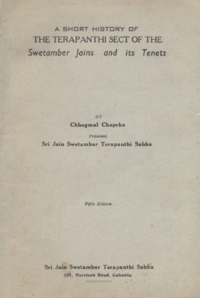We shall now conclude the history of fasts with that of Swāmiji Asharamji Maharaj. This Sadhuji of the Tera-panthi Sect was a native of Balotra, Marwar state. He was the son of Surajmalji Bhandari and was an Oswal by caste. He had been married before he was initiated but a soul out to conquer the passions and attachments of this world cannot continue in a householder's state. On Sravan Sudi 7, Samvat 1970 he became initiated as a Sadhu and severed all worldly attachment and performed the following fasts:
1 day fast | 2 days' fast | 3 days' fast | 4 days' fast |
1367 | 630 | 111 | 14 |
5 days' fast | 6 days' fast | 7 day's-fasfc | 8 day's fast |
25 | 1 | 2 | 3 |
9 days' fast | 10 days' fast | 11 day's fast | 12 days' fast |
1 | 1 | 2 | 1 |
13 days' fast | 15days', fast | 25 days' fast | 30 days' fast |
1 | 1 | 1 | 1 |
31 day's fast | 35 days' fast | 41 days' fast |
|
2 | 1 | 1 |
|
Besides the above fasts for 6 years he regularly fasted every alternate days and for 6 years he fasted for 2 consecutive days and took food on the third day. His immortal soul left this world on Chait Badi 7, Samvat 1989 (13th March, 1933) after a continuous fasting for 73 days at Charwas in Bikaner state. On the 59th day of his fasting he took the vow of abstention from all food and drink except water for the rest of his life and for 7 days he observed the vow of absolute abstention from all food and drink. While a householder he had fasted for 30 days and did other fasts several times.
There is generally a systematic arrangement made at the beginning of the Chaturmasa (Sravan Badi 1 to Kartik Sudi 15) according to which laymen undertake to fast on more than one day of the month. Some fast for several consecutive days during Sravan Badi 1 to Bhadwa Sudi 3 (the Samvatsari day). In every town where a Sadhuji stays during the rainy season, a list of these fasts is prepared.
In these days when so much advertising and publicity are restored to in the case of fastings for political, social or other secular objects, it is refreshing to note that in this world of materialism, there are souls even now who take delight in resorting to fasting for the uplift and purification or their soul, without advertising or giving publicity to it in any way. In fact the Jain Sastras strictly enjoin that in case of long fasts the public should not know when the fast would be completed. These fasts are observed by Sadhus and the laymen also are advised to observe fasts as a means to get rid of Karmas which bind the soul to the mundane world. Fasts undertaken for secular purposes and for earthly benefits do not benefit the soul, according to the Jain Sastras. The hardship endured on such secular fasts may not be altogether useless, but it is frittering away a precious thing for a trifle only. It is like selling a brilliant diamond for a farthing.
 Chhogmal Choprha
Chhogmal Choprha
